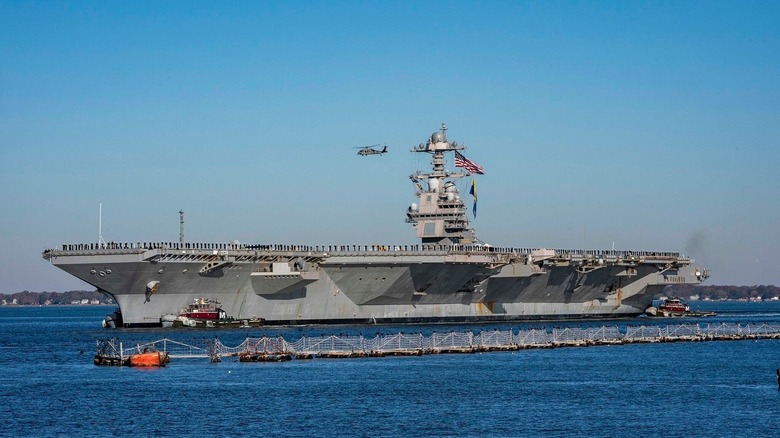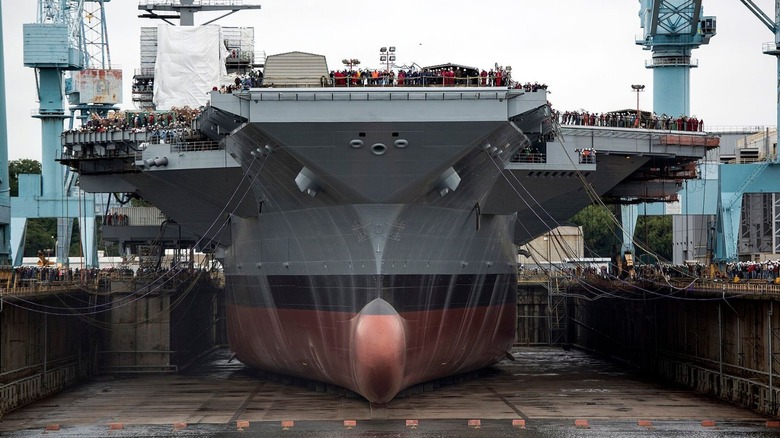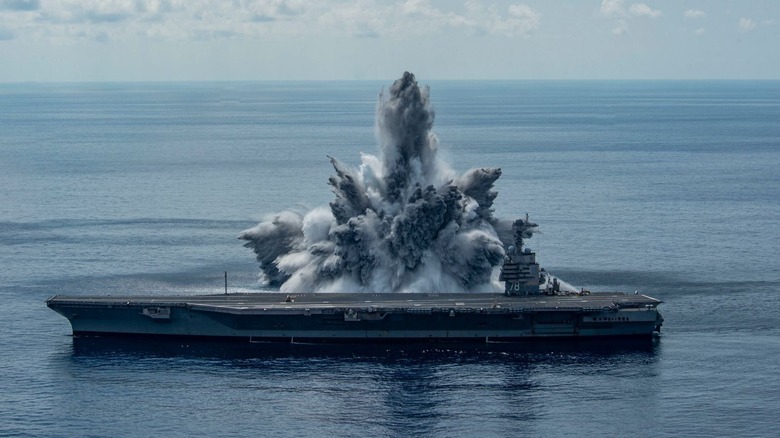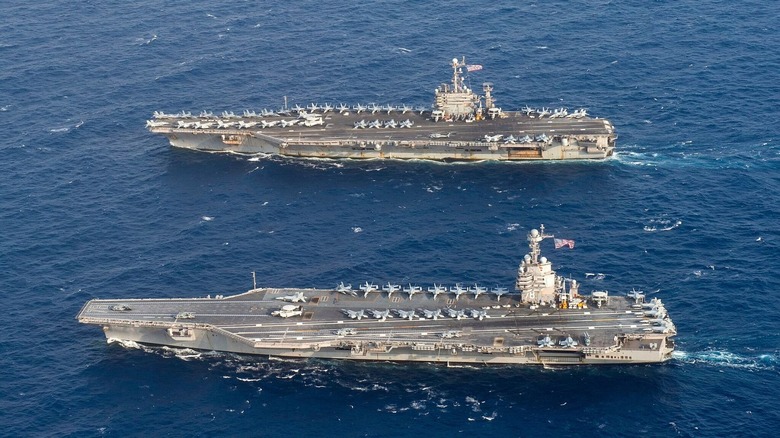All About The USS Gerald R. Ford (CVN 78) Aircraft Carrier & And Where Its Homeport Is
Dubbed the "most capable, adaptable, and lethal combat platform in the world" by its official mission statement, the USS Gerald R. Ford (CVN 78) serves as the leading nuclear-powered aircraft carrier in the U.S. Navy. Named for the nation's 38th president, USS Gerald R. Ford is the largest warship in the world, surpassing even its predecessor, the Nimitz-class carrier introduced in 1975. The carrier isn't just big, though. It's innovative, improving upon the Nimitz to enhance the firepower of the contemporary U.S. Navy.
Though only commissioned into service by former President Donald Trump in 2017 and launched on its first full deployment in May 2023, CVN 78 has been fairly active. Only six months after being deployed for NATO exercises in Norway, USS Gerald R. Ford diverted to the Eastern Mediterranean after the Hamas attack on Israel. In January 2024, CVN 78 and her crew returned to Naval Station Norfolk, the aircraft carrier's homeport. As of July 2024, USS Gerald R. Ford is homeported alongside 44 other ships, including the carriers Dwight D. Eisenhower, George Washington, Harry S. Truman, and George H. W. Bush.
[Featured image by U.S. Department of Defense via Wikimedia Commons | Public Domain]
Improvements from the Nimitz-class carrier?
As the follow-up to the Nimitz-class carrier, USS Gerald R. Ford had to justify its $13 billion construction cost. In a side-by-side comparison, there may appear to be few differences. They're both propelled by two nuclear reactors and can reach speeds of around 30 knots. CVN 78 is longer, at 1,106 feet compared to 1,092 feet, and can carry around 30 more aircraft.
One of USS Gerald R. Ford's most essential improvements is its electromagnetic launching system, replacing the older steam-powered catapult. With the new catapult, USS Gerald R. Ford is expected to increase the number of flights (sorties) by 33%, up to 160 per day outside of wartime conditions. Included in those sorties is an expected increase in the number of unmanned aircraft. With an increased number of sorties and a variety of aircraft being flown, a larger flight deck was necessary. To accommodate this, the carrier's "island," or the command center, was moved further back on the hull.
[Featured image by U.S. Navy via Wikimedia Commons | Public Domain]
Armament of CVN 78
As big as USS Gerald R. Ford is, without advanced armament and a means of defense, it could be dead in the water when faced with a foe. Leading its defenses is a long-range radar that alerts when armaments such as the Phalanx Close-In Weapon System (CIWS) — which is considered the vessel's last line of defense — should be readied. Modifications to the rapid-fire CIWS have made it more effective against incoming aerial craft but also have opened the door for it to target surface threats such as small boats
Along with the CIWS, Ford can launch Evolve Sea-Sparrow Missiles (ESSM) and Rolling Airframe Missiles (RAM) to defend against enemy sorties. The real firepower of any carrier is its aircraft, and CVN 78 is capable of housing more than 75 under normal conditions, and potentially around 90. USS Gerald R. Ford also houses E-2D Advanced Hawkeyes, which provide early warnings with a 360-degree radar.
[Featured image by U.S. Navy via Wikimedia Commons | Public Domain]
Ford's first major deployment
In October 2022, USS Gerald R. Ford departed on its first operation, joining allied navies in the Atlantic as the flagship of the Gerald R. Ford Carrier Strike Group (GRFCSG). Part an opportunity to bolster defenses in the Atlantic, the deployment also allowed the carrier's crew to demonstrate the future of aircraft carriers. Almost exactly a year later, CVN 78 was given the opportunity to further showcase its power when the United States responded to an attack on Israel by the Palestinian militant group, Hamas.
USS Gerald R. Ford and the GRFCSG were sent to aid Israel and provide firepower support in the event of another attack. Though the carrier remained in the Eastern Mediterranean, support vessels from the GRFCSG sailed into the Red Sea and shot down ballistic missiles and drones launched from Yemen. By January 2024, CVN 78 and its fleet were ordered back to Norfolk. During her eight months away from her homeport, USS Gerald R. Ford launched over 10,300 sorties and logged over 83,000 nautical miles.
[Featured image by U.S. Navy via Wikimedia Commons | Public Domain]



